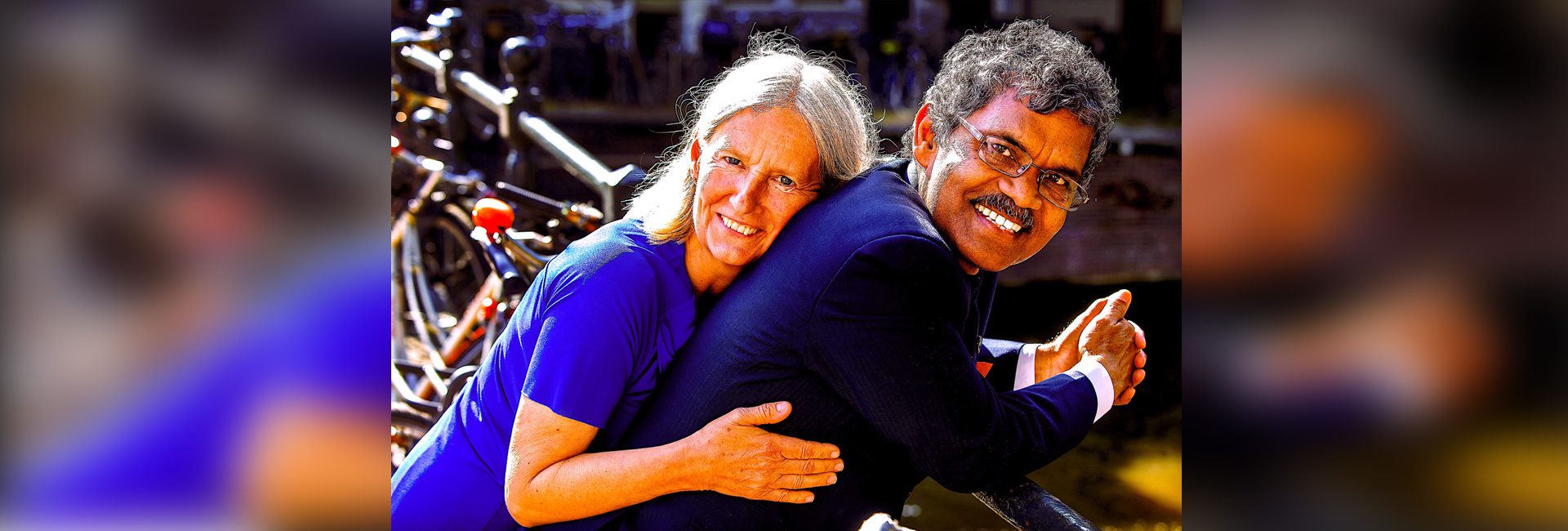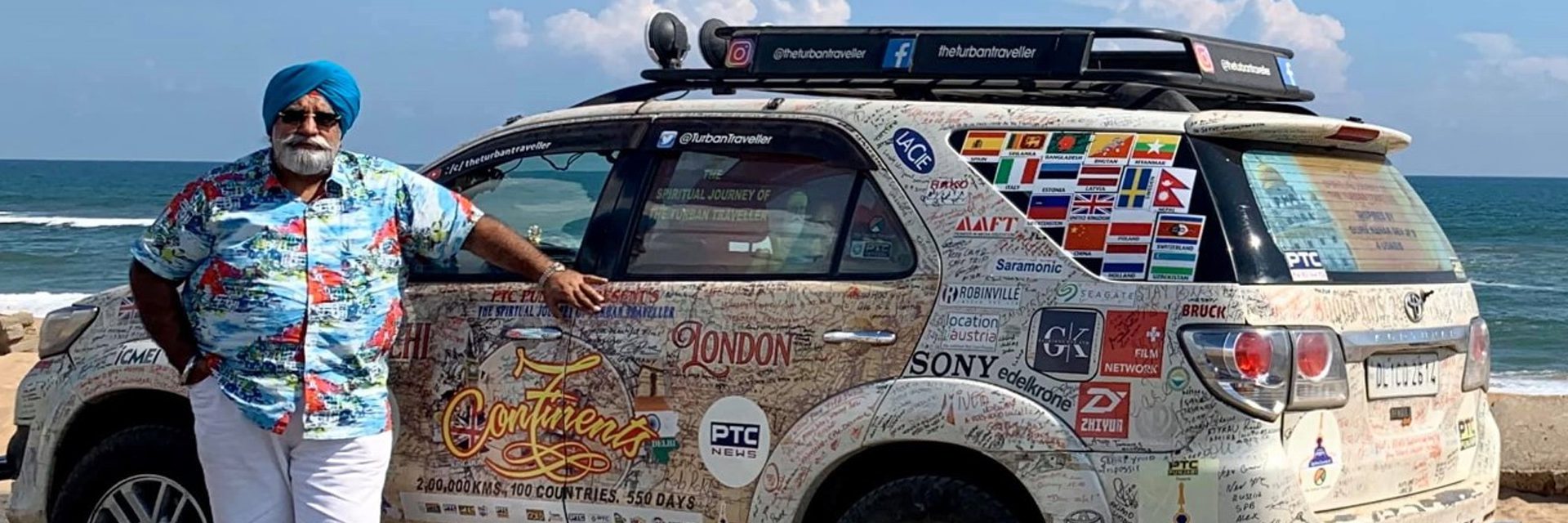(August 28, 2022) It was in the crisp winter of 1975 that PK Mahanandia saw a woman tourist approach him in the inner circle of Delhi’s bustling CP, asking him to draw a portrait of her. The Indian artist, who had by then earned quite a reputation as a sketch artist, was known for making a portrait in ten minutes. But somehow, he wasn’t able to deliver a perfect portrait, which made Charlotte Von Schedvin, the Swedish tourist, return to him the following day. It was a prophecy that kept him distracted – one that was made by a priest when he was a child growing up in a village in Odisha – he would marry a girl from far away who would own a jungle, be musical, and be born under the sign of Taurus. And Charlotte was everything that had been prophesised. “It was an inner voice that said to me that she was the one. During our first meeting, we were drawn to each other like magnets. It was love at first sight,” PK Mahanandia told BBC. This very love made him cycle 6000 km from Delhi to Sweden on a life-changing epic journey. Now an advisor for art and culture for the Swedish government, he inspired the 2013 book by Per J Andersson called The Amazing Story Of The Man Who Cycled From India To Europe For Love.

PK Mahanandia and Charlotte
Born in 1949 in a village that inspired Rudyard Kipling’s The Jungle Book, PK’s life as a Dalit was harsh outside his home. It was in school that he first understood the meaning of caste when he came in contact with the Hindus. From being forced to sit outside the class during school, watching his classmates wash themselves after coming in contact with him, to having stones pelted at him for approaching the temple, PK endured the harsh reality of being an untouchable in India. “There I felt I’m not the same as them. It’s like a skyscraper without a lift. You’re born on one floor and you die on the same floor,” the Global Indian told National Geographic.
Despite the hardships, PK knew he was meant for something bigger, at least that’s what the priest had prophesised after his birth – he would be working with colours and art. As a kid, he was pulled to art and was quick in drawing things. So much so that eventually he ended up getting a scholarship from Odisha to attend the College of Art in New Delhi. The initial months were liberating, as for the first time, PK didn’t have to bother about being an untouchable, here, all were equal. But soon the excitement started to fade away as hunger and poverty came knocking on his door. With no money to keep him floating, things started spiralling until he began painting on the streets of Delhi to earn a quick buck. “I was like a vagabond living between hope and despair. But for three years I learned the lessons of life. I started thinking differently after I met these people,” the artist added.
After his schooling, he enrolled in College of Art, Delhi in 1971
He started studying fine arts on a scholarship
It was difficult because most of the time, the scholarship amount didn’t reach him and finding a job was difficult because of the discrimination he’d face as a dalit pic.twitter.com/0GIecjA2QJ
— Sufyan🌹 (@PsyOpValkyrie) July 25, 2020
But things changed for him when he ended up doing 10 portraits of Soviet astronaut Valentina Tereshkova and appeared on television. The stint made him an overnight star in the capital and helped him continue making portraits in the heart of Delhi. But it was in December 1975 that the prophecy came to fruition when the artist met a “woman with long beautiful blonde hair” from a faraway land whose family did own a forest and who played the piano and flute. With a longing for India, she had travelled for 22 days in a minibus along the Hippie Trail to reach India. They hit it off instantly and formed a deep connection, so much so that within a few days, Charlotte was on a train with PK to his village in Odisha to meet his family, where they received the tribe’s blessings. But soon Charlotte’s trip was coming to an end, and she returned to Sweden with a promise from PK that he would follow her soon to Europe.
But that all changed when he was at a procession one day
It was for Valentina Treskova, the first woman cosmonaut from the USSR
He quickly made a sketch of her a presented it to her. The next day all newspapers went ablaze with headlines like “Woman from Space meets Jungleman”. pic.twitter.com/YWAOXfXrA3
— Sufyan🌹 (@PsyOpValkyrie) July 25, 2020
With just $80 in his pocket, he left for Sweden in the chilly winter of January 1977 on two wheels, as “only a Maharaja could afford a plane ticket” in those days. So he took the popular Hippie Trail that stretched from India through Pakistan, Afghanistan, Iran, Turkey, and former Yugoslavia to Europe. Travellers didn’t need a visa at that time as the region was safe and stable. “We were together 2-3 weeks and then she left. For one and a half years we didn’t meet. We kept in touch by letter but eventually, I thought it was time to take the first step. So I sold everything I owned and bought a bicycle,” he told NatGeo. Those four months on the road, he kept himself floating by painting portraits for food and money.
On 17 Dec 1975, he met a girl from Sweden called Charlotte von Schedvin who had driven for 22 days to reach Delhi.
Although their vast class difference (she was from Swedish nobility and he was a dalit), they hit it off almost instantly. pic.twitter.com/rRejClj1mH
— Sufyan🌹 (@PsyOpValkyrie) July 25, 2020
“I did not know geography, of how big Europe was. I didn’t even know the distance in kilometers. If I had known how far it was, I don’t think I would have dared. It’s good that I didn’t know,” he told Hindustan Times in an interview. He would cycle up to 70 km every day, but there were days that he would get lifts, and was once even gifted a train ticket from Istanbul to Vienna. “Sometimes you’d get two or three hitchhiking offers and you’d have to choose. I bicycled for love, but I never loved biking,” he told CNN.
PK calls it a different world of peace and love, and freedom. With many hippie friends made on the way, he was guided and instructed on his first big adventure outside India. “Afghanistan was such a different country. It was calm and beautiful. People loved the arts. And vast parts of the country were not populated,” he told BBC. While he did face communication barriers in Iran, it was art that came to his rescue. “I think love is the universal language and people understand that.” Though the 6000 km journey was exhausting for the artist, it was the excitement of meeting Charlotte and seeing new places that kept nudging him forward.

This cycle on which travelled from India to Europe
It was in May that PK reached Europe – via Istanbul, and Vienna and finally made it to Gothenburg (Sweden) by train. However, stepping into a new continent came with its share of cultural shocks and difficulties. But he was determined to win over Charlotte’s parents, and finally, the two got officially married in Sweden. “I had no idea about European culture. It was all new to me, but she supported me in every step. She is just a special person. I am still in love just as I was in 1975,” he added.
While Charlotte continued her career in music, PK did what he knew best – art. Currently, an adviser on art and culture for the Swedish government, he was nominated for the Nobel Peace Prize in 2005. In the last few decades together, the couple has dedicated themselves to promoting indigenous arts and offering cultural scholarships to 25,000 Indian tribal children in high school. “Love has given me the power to forgive the people throwing stones at me. They need education. I’m glad that our story is giving people hope,” the artist told CNN.




I regard the story as a world-rapture.